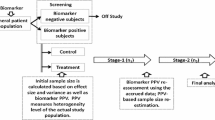Abstract
Biomarker studies often try to identify a combination of measured attributes to support the diagnosis of a specific disease. Measured values are commonly gained from high-throughput technologies like next generation sequencing leading to an abundance of biomarker candidates compared to the often very small sample size. Here we use an example with more than 50,000 biomarker candidates that we want to evaluate based on a sample of only 24 patients. This seems to be an impossible task and finding purely random-based correlations is guaranteed. Although we cannot identify specific biomarkers in such small pilot studies with purely statistical methods, one can still derive whether there are more biomarkers showing a high correlation with the disease under consideration than one would expect in a setting where correlations are purely random. We propose a method based on area under the ROC curve (AUC) values that indicates how much correlations of the biomarkers with the disease of interest exceed pure random effects. We also provide estimations of sample sizes for follow-up studies to actually identify concrete biomarkers and build classifiers for the disease. We also describe how our method can be extended to other performance measures than AUC.
Access this chapter
Tax calculation will be finalised at checkout
Purchases are for personal use only
Similar content being viewed by others
Notes
- 1.
This is a more or less realistic assumption for microarray and next generation sequencing data but not for data from mass spectrometry.
- 2.
The data set is currently submitted to a medical journal.
- 3.
The HAUCA curves were neither available nor discussed in the paper [10].
References
De Angelis, G., Rittenhouse, H., Mikolajczyk, S., Blair, S., Semjonow, A.: Twenty years of PSA: from prostate antigen to tumor marker. Rev. Urol. 9(3), 113–123 (2007)
Lichtinghagen, R., Pietsch, D., Bantel, H., Manns, M., Brand, K., Bahr, M.: The enhanced liver fibrosis (ELF) score: normal values, influence factors and proposed cut-off values. J. Hepatol. 59(2), 236–242 (2013)
Ambroise, C., McLachlan, G.J.: Selection bias in gene extraction on the basis of microarray gene-expression data. Proc. Natl. Acad. Sci. 99(10), 6562–6566 (2002)
Varma, S., Simon, R.: Bias in error estimation when using cross-validation for model selection. BMC Bioinform. 7(91), 1 (2006). doi:10.1186/1471-2105-7-91
Omar, M., Klawonn, F., Brand, S., Stiesch, M., Krettek, C., Eberhard, J.: Transcriptome-wide high-density microarray analysis reveals differential gene transcription in periprosthetic tissue from hips with low-grade infection versus aseptic loosening. J. Arthroplasty (2016, to appear). doi:10.1016/j.arth.2016.06.036
Hand, D.: Measuring classifier performance: a coherent alternative to the area under the ROC curve. Mach. Learn. 77, 103–123 (2009)
Flach, P., Hernández-Orallo, J., Ferri, C.: A coherent interpretation of AUC as a measure of aggregated classification performance. In: Proceedings of the 28th International Conference on Machine Learning (ICML 2011), pp. 657–664 (2011)
Mason, S.J., Graham, N.E.: Areas beneath the relative operating characteristics (ROC) and relative operating levels (ROL) curves: Statistical significance and interpretation. Q. J. Royal Meteorol. Soc. 128(584), 2145–2166 (2002)
Holm, S.: A simple sequentially rejective multiple test procedure. Scand. J. Stat. 6, 65–70 (1979)
Szafranski, S., Wos-Oxley, M., Vilchez-Vargas, R., Jáuregui, R., Plumeier, I., Klawonn, F., Tomasch, J., Meisinger, C., Kühnisch, J., Sztajer, H., Pieper, D., Wagner-Döbler, I.: High-resolution taxonomic profiling of the subgingival microbiome for biomarker discovery and periodontitis diagnosis. Appl. Environ. Microbiol. 81, 1047–1058 (2015)
Demler, O., Pencina, M., D’Agostino, R.S.: Impact of correlation on predictive ability of biomarkers. Stat. Med. 32, 4196–421 (2013)
Montvida, O., Klawonn, F.: Relative cost curves: An alternative to AUC and an extension to 3-class problems. Kybernetika 50, 647–660 (2014)
Hand, D., Till, R.: A simple generalisation of the area under the ROC curve for multiple class classification problems. Mach. Learn. 45, 171–186 (2001)
Li, J., Fine, J.: ROC analysis with multiple classes and multiple tests: methodology and its application in microarray studies. Biostatistics 9, 566–576 (2008)
Li, J., Fine, J.: Nonparametric and semiparametric estimation of the three way receiver operating characteristic surface. J. Stat. Plan. Infer. 139, 4133–4142 (2009)
Hernández-Orallo, J.: Pattern Recogn. ROC curves for regression 46(12), 3395–3411 (2013)
Novoselova, N., Della Beffa, C., Wang, J., Li, J., Pessler, F., Klawonn, F.: HUM calculator and HUM package for R: easy-to-use software tools for multicategory receiver operating characteristic analysis. Bioinformatics 30, 1635–1636 (2014)
Author information
Authors and Affiliations
Corresponding author
Editor information
Editors and Affiliations
Rights and permissions
Copyright information
© 2016 Springer International Publishing AG
About this paper
Cite this paper
Klawonn, F., Wang, J., Koch, I., Eberhard, J., Omar, M. (2016). HAUCA Curves for the Evaluation of Biomarker Pilot Studies with Small Sample Sizes and Large Numbers of Features. In: Boström, H., Knobbe, A., Soares, C., Papapetrou, P. (eds) Advances in Intelligent Data Analysis XV. IDA 2016. Lecture Notes in Computer Science(), vol 9897. Springer, Cham. https://doi.org/10.1007/978-3-319-46349-0_31
Download citation
DOI: https://doi.org/10.1007/978-3-319-46349-0_31
Published:
Publisher Name: Springer, Cham
Print ISBN: 978-3-319-46348-3
Online ISBN: 978-3-319-46349-0
eBook Packages: Computer ScienceComputer Science (R0)




